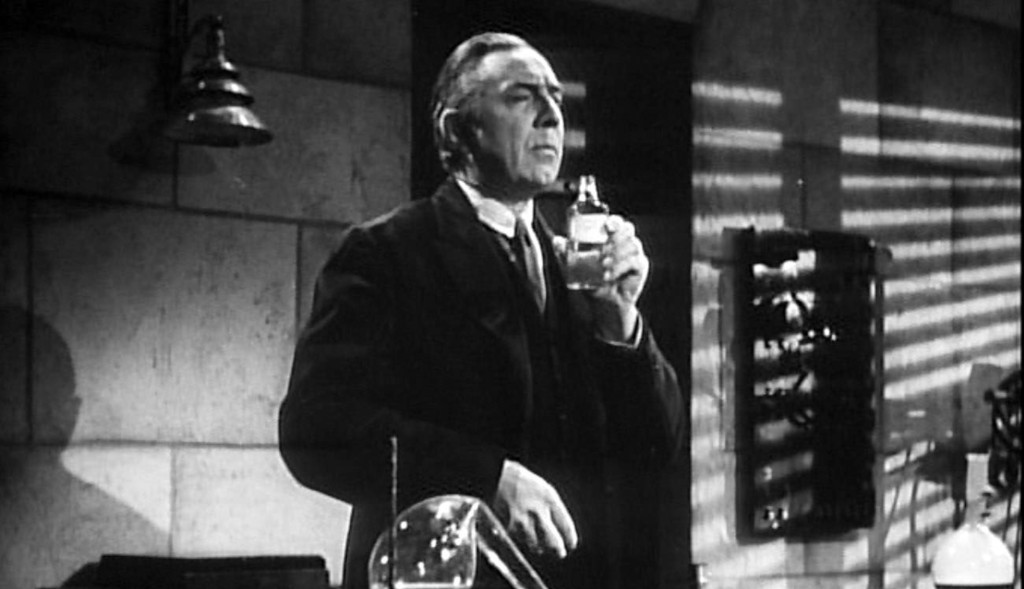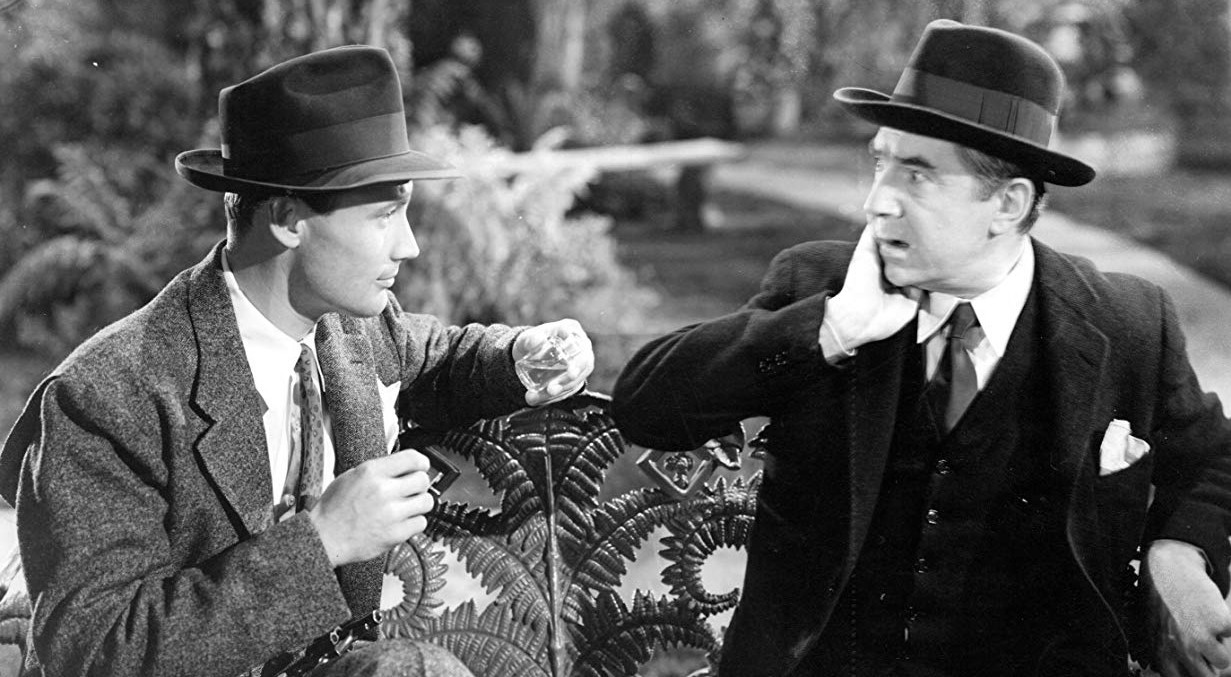(5/10) Poverty Row studio PRC’s 1940 horror comedy is a terrible movie. Bela Lugosi plays a perfume maker who creates a Franken-bat and trains it to murder people wearing the new aftershave he sells them. Lugosi winks at the audience in a wonderful performance, and the madness of it all simply disarms the viewer.
The Devil Bat. 1940, USA. Directed by Jean Yarbrough. Written by John T. Neville & George Bricker. Starring: Bela Lugosi, Suzanne Kaaren, Dave O’Brien, Guy Usher, Donald Kerr, Yolande Donlan. Produced by Jack Gallagher. IMDb: 5.5/10. Rotten Tomatoes: 58 % Fresh. Metacritic: N/A.

Where to begin? Well let’s begin with Bela Lugosi, the star of this film. By 1940 Lugosi’s career was not yet as completely in the ruts as it would later sink. He was hot off the huge success of Son of Frankenstein (1939, review), and would yet land a few decent roles in films like The Wolf Man (1941) and Ghost of Frankenstein (1942, review). It was his abysmal performance (with no help from the editor who took out all his lines) in Frankenstein Meets the Wolf Man (1943, review) that would finally sink his career, along with the waning popularity of the Universal monsters and Lugosi’s own health and drug problems. In fact 1939-1942 was something of a second coming of Lugosi, who, despite being broke, had made only one film serial in 1937 and not a single production in 1938. But despite this, The Devil Bat was certainly a taste of things to come for Bela – a cheapo by Poverty Row studio PRC, surrounded by an incompetent cast and a crew that seemed like they really couldn’t care less.

The film follows Dr. Paul Carruthers, who apparently is American, even though he speaks with a Hungarian accent not unlike Bela Lugosi’s. Carruthers is a kindly town doctor, who also happens to be employed by a family-owned perfume business that’s become rich on his inventions. Feeling that he has been cheated out of his money, he secretly uses electricity to enlarge a bat to monstrous proportions (a few feet wide, that is), and teaches it to hate a certain potion that he has brewed. He then tricks his victims (the business family) to put the ”aftershave lotion made from my new forrrmyula” on their necks, and later releases the bat, which darts through the air like a jet plane and follows the scent to his victims.
Baffled by the recent deaths in the area, reporter Johnny Layton (Dave O’Brien) and photographer One-Shot McGuire (Donald Kerr) start investigating – all while Layton falls in love with the business mogul’s daughter Mary Heath (Suzanne Kaaren), and One-Shot takes a liking to her sexy French maid Maxine (Yolande Donlan). They follow leads here and there, and the police refuse to believe that Dr. Carruthers might be involved, despite him being close to all the victims, his aftershave is found with all the victims and that he seems to have a motive.
More people are killed. Bela Lugosi does his best parody of himself and One-Shot and Layton crack bad jokes. Maxine lifts her skirt up to knee height. Carruthers is killed by his own bat. Layton and Mary smooch. The end.

This film was directed by Jean Yarbrough, who is best known for having directed a bunch of Abbot & Costello flicks, which should tell you all you need to know about the tone of the movie. It is the sort of horror comedy that proved so popular in the forties. As described above, the plot is paper-thin, and the developments outright daft. Would you not think perhaps, that a doctor who serves as a personal physician to his victims would find a slightly easier way of disposing of them, than by first creating a Franken-bat, then somehow luring his victims to put on an aftershave that he has had to concoct for the purpose, make the bat kill at the smell of the aftershave, let the bat out and hope for the best? Perhaps he could just poison them or something? Not to mention the fact that his own lab bust reek of the aftershave, and it is next door to where the bat sleeps, making him the obvious target. And the further the film goes, it becomes harder and harder to believe that the police, the family and almost everyone involved balk at the idea that good old Carruthers could somehow be guilty. They basically catch him red-handed and still the script tries to find ways to make them reject the notion. It’s the kind of movie that makes you bang your head on the table over the excruciating stupidity of all the characters.

Furthermore, there is a subplot involving the two reporters setting up a fake bat in a picture for their newspaper, which gets spotted and they lose their jobs and … well, does anybody really care?. The subplot is unnecessary and feels like it is there just to fill out time, which makes the film drag even at its short 68 minutes in length. O’Brien has the leading man look, and although he is no John Barrymore, he does what he can with the shallow role. In fact he doesn’t do all too bad, but his performance is ruined by boring camera-setups, uninterested direction, static filming and clumsy editing. Donald Kerr has some nice comedic timing and a fun, jovial charisma, but he is underused, giving all the focus to O’Brien. O’Brien would later find some manner of fame through a recurring role in PRC:s series of Texas Ranger films. Comedic talent Kerr has an impressive resumé of close to 500 appearances in films, serials and TV series, and thus it is a bit sad that his most famous roles are that of One-Shot McGuire in The Devil Bat and as Happy Hapgood in Flash Gordon’s Trip to Mars (1938).

Leading lady Suzanne Kaaren was a high-jumper turned model turned actress, and is adequate in her role as Mary Heath, although as Kristen Lopez points out in Journeys in Classic Film: ”her role requires physical attractiveness alone”. Kaaren is best known today for this role, but back in the day she was a minor star when she ”appeared decoratively” in almost all of The Three Stooges’ short films. As a publicity stunt the studio (not PRC, mind you) had her long legs insured for one million dollars. In the eighties she caused some hilarious controversy when she refused to move out of a building that Donald Trump wanted to demolish. Over ten years later Trump was able to buy her apartment for 750 000 dollars.
The French maid Maxine was the third movie role of Yolande Donlan, and she mostly says ”Oui, I don’t understand”. Despite this, she gives the best performance in the film. Donlan was in fact a very good actress, and went to some fame on stage, which brought her to Britain when spotted by Laurence Olivier. There she married director Val Guest, appeared in some highly praised stage roles in London, and became a minor movie star in England. Val Guest wrote and directed eight films with her in the lead, and she acted in several more, including a few in the States. Although she was best known for her cheeky and energetic performances in comedies, she also gave proof of her dramatic talents in some dramas and thrillers. Her most famous films are probably The Devil Bat, Penny Princess (1952), Tarzan and the Lost Safari (1957), Jigsaw (1957) and 80,000 Suspects (1962). She was married to Guest until his death in 2006, and passed away herself in 2014. The Guardian writes: ”In what is deemed the most lacklustre period of British film history, the American actor Yolande Donlan, who has died aged 94, brought a welcome touch of Hollywood glamour. /…/ Though few would claim as masterpieces the eight films she made with the prolific British director Val Guest /…/, they were reasonably entertaining low-budget movies which gave Donlan the chance to display her vivacity and versatility.”

The rest of the cast is interchangeable, although there is a supporting part by Arthur Q. Bryan, the original voice of Elmer Fudd.
The film has a wonderful redeeming quality, though: Bela Lugosi. The thing that sets this film apart is that this time Lugosi is in on the joke, as opposed to many of the later films and appearances he made. Lugosi walks that fine line between creepy and funny and does a subtle send-up of his previous roles. The way he coerces the men he wishes to kill to put on his new aftershave is hilarious, telling them to ”put some over the jugular vein”, and ”on the soft part of the skin on the side of the neck”, smiling broadly all the while. It’s comedy gold and at the same time wonderfully morbid. He speaks his morbid double entendres with pure delight, stressing just the right words, giving his seemingly kind words an ominous meaning. Had it not been for the fact that the film’s direction is so rotten and the script so bad, this could have been one of Lugosi’s finest moments.

But unfortunately, the direction of the film is hamfisted, and there is not nearly enough plot to stretch to 68 minutes. Neither is there a budget to make anything out of those stretched scenes. Thus we get Bela Lugosi in a dark basement lab wearing goggles and looking through a view hole at a flickering light out of frame, smiling his evil smile. For a long time. Cut to a bunch of Strickfadens. Cut back to Lugosi. Back to the Strickfadens. Back to Lugosi. Then he enters the other room where an obvious rubber bat hangs immobile. He talks to it. Exposition. Not that much is needed. Then we cut to a stock shot of the head of a real fruit bat. It looks nothing like he rubber bat. Then we cut back to a wide shot of Lugosi and the rubber bat. He talks to it some more. Then he walks out and puts his goggles on again. He turns the lever and there is more sparkling and blinking. For another long stretch of time. And then there’s a long scene with Lugosi rummaging around his lab, for no apparent reason. And so on.
The bat in action looks just like a big rubber bat. Sometimes it flaps loosely as if obviously hung from a string. Other times it just has its wings spread stiffly and SWOOSHES through the air like a fighter jet, smashing into the victims’ faces.

While Hollywood was dominated by the ”big eight” studios, Producer’s Releasing Corporation (PRC) quickly rose to become one of the four leading studios on Poverty Row, in part thanks to the success of The Devil Bat. The studio was founded in 1939 and The Devil Bat was only its tenth film. As with most PRC pictures, it had a budget under 100 000 dollars, and it shows. Most of the film’s budget must have gone into Lugosi’s lab and film stock. The bat looks like it’s bought from a Halloween shop and there isn’t any set design to speak of besides the crude and cramped laboratory. Apart from the flying bat, there aren’t any special effects either. The music is fairly effective, but compiled from canned stock. The quality of the film is further proven by the fact that the titles get two of the actors’, the sound recorder’s and even the director’s names spelled wrong.
Yet, despite all its shortcomings, the film has a certain charm to it, which springs from the fact that the lead actors are all quite likeable, and that it treads a comforting line between comedy and thriller. Bela Lugosi gives it some star quality, and as mentioned above, does a great job within his limited acting range – his hilarious hamming is just right for the film, and he does it with a wink to the audience. Without him, this film would have gone on my list of awful movies, but as it stands it is a mildly enjoyable movie, especially if you are a fan of old B-films. It proved to be the most successful of PRC:s horror films, and was such a hit with the audience that it garnered a sequel in 1946: The Devil Bat’s Daughter. It was remade the same year as The Flying Serpent.

Art director Paul Palmentola thoroughly acquainted himself with B-movie sci-fi over the years to come. He moved to serial making, designing sets for Brick Bradford (1947), Superman (1948), Bruce Gentry, Batman and Robin (both 1949), Atom Man vs. Superman (1951), Mysterious Island (1952), Captain Video, Master of the Stratosphere, The Lost Planet (both 1953) and Adventures of Captain Africa, Mighty Jungle Avenger! (1954). He then turned to films like It Came from Beneath the Sea, Creature with the Atom Brain (both 1955, review), Earth vs. The Flying Saucers (1956, review), and last but not least, the film we love to hate here on the blog: The Giant Claw (1957, review).
No-one exists that thinks this is a good film, so the question that reviewers have to ask themselves is whether this is so bad that it becomes good or if it’s simply bad. Never afraid to deal out a low rating, Richard Cross at 20/20 Movie Reviews falls squarely in the second category, giving The Devil Bat 0/4 stars. Dario Lavia at Cinefania gives the film a bit more slack, dealing out 1.5/5 stars. Derek Winnert goes half a star further, awarding the movie with 2/5 stars, just like Dutch Cinemagazine, and Richard Scheib at Moria, wring that The Devil Bat features “one of the tattiest looking screen bats ever”. The Terror Trap goes higher with 2.5/5 stars, and Graeme Clark at The Spinning Image lays out what I think is the highest ranking I’ve seen for the picture, 6/10 stars. I think TV Guide misses the point of ranking films, as it only dares to rank The Devil Bat as a 1/5 star movie, but writes that it “is still simply too much fun to dismiss”. Why then the sour face?

From any serious cinematic point of view The Devil Bat is a terrible film. The script, the dialogue, the direction, the cinematography, the logic (what logic?), the acting, the effects. But as Chris Hartley writes at The Video Graveyard: “If you’re willing to keep low expectations and just go along with the craziness that is Lugosi, and you also happen to be a fan of the creaky genre pictures being made in these early decades of cinema, then you’ll probably enjoy yourself”. Of course, this is subjective, but if I had to choose between re-watching, say, a competently made, streamlined, Boris Karloff programmer like The Man With Nine Lives (1939, review), acknowledged by most horror fans as a reasonably good film, and the howling madness of The Devil Bat, I’ll take latter any day. It’s just so much fun.
Janne Wass
The Devil Bat. 1940, USA. Directed by Jean Yarbrough. Written by John T. Neville & George Bricker. Starring: Bela Lugosi, Suzanne Kaaren, Dave O’Brien, Guy Usher, Donald Kerr, Yolande Donlan, Edmund Mortimer, Gene O’Donnell, Alan Baldwin, John Ellis, Arthur Q. Bryan, Hal Price, John Davidson, Wally Rairden. Cinematography: Arthur Martinelli, Editing: Holbrook Todd. Art direction: Paul Palmentola. Production manager: Melvin De Lay. Sound: Ferrol Redd. Musical director: David Chudnow. Produced by Jack Gallagher for PRC.

Leave a comment